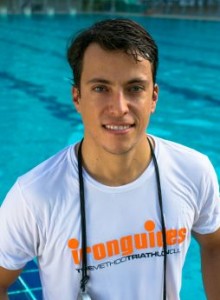Ironman Melbourne Course Review – by Vinnie Santana – ironguides.net
The inaugural Ironman Melbourne proved one for the record books; a stacked field of professional athletes, including several world champions, delivered a Sub-8 hour performance by Craig Alexander and an oh-so-close Sub-8 for Cameron Brown, who finished second in an 8:00:12 personal best. Not to be outdone, female winner Caroline Steffen crossed the line in 8:34:51, smashing her PB by about half an hour; she is now the world’s second-fastest Ironwoman behind Chrissie Wellington.
I was fortunate enough to be down there supporting a group of athletes and witness the action firsthand. Here are my tips for athletes considering taking part in this event in the coming years.
I would definitely recommend this race for first timers; it will certainly provide a fun experience and conditions are relatively friendly, even in the very worst-case scenarios. Athletes seeking a Personal Best will find this race their winning lottery ticket as it is a very fast course with all the components that help speedy finish times: a wetsuit swim, cold weather, a flat bike and run, and swift competition.
The level of competition in Australian races is very high. Ironman Melbourne offers a great number of slots to the World Championships in Kona (75 this year and next). However, be ready to perform at a top level, i.e. high speed, if you are aiming to secure one since the combination of a fast course and strong competition makes this one of the fastest qualifying courses on the ironman circuit.
One downside involves the logistics of having two transition zones that are 42km apart. This makes it hard for supporters to follow the race, spreads the crowds on the run course which makes it relatively lonely and quiet for the athlete, and requires a very early wake-up as athletes still need to commute almost an hour to the start line in Frankston from the official hotel, and IM city, in St Kilda.
Finally, Melbourne is famous for offering all weather types in one day. Two days out from race day it was extremely windy—the chop in the water was such that I imagine the swim would have been cancelled if conditions had been the same on race day. If you plan to compete in Melbourne over the next few years and the race remains around the same time of the year, bring gear for all conditions and be ready for a blustery day, which may also impact equipment choice such as race wheels.
SWIM
Be mentally prepared to swim in the dark and use goggles with clear lenses. By the time the swim starts, the sun is not out yet. Most swimmers reported feeling lost during the first 10 minutes of the swim since it starts parallel to the shore and the lights on stand-up paddleboards get mixed with lights from nearby towns on the horizon. Find a pack to swim with so that it can help you navigate until the sun comes out.
Use a long-sleeve wetsuit as it helps protect you from the cold water and also will help you be warmer when starting out on the bike.
Wetsuit swims put a strain on the shoulders that you want to simulate in training. Do sets with a pullbuoy and paddles to mimic the extra flotation of the wetsuit with the increased strain on the shoulders. Example as below:
Warm up, then do main set:
With pullbuoy and paddles do 1 to 3 times 1.2km as:
400m HARD – 10sec rest
400m moderate – 10sec rest
400m easy
2min rest between each 1.2km set
This session simulates race start; flat out for the first third (note: don’t use the wall to push off as you don’t in the race either), then settle into a cruise pace for the second 400m, and then go easy in the last 400m to loosen up and recover for the next 1.2km set.
BIKE
It’s a two-lap course on a highway, with the first half lap on a very light incline and likely headwind, while the ride home is much faster on a slight downhill and with a tailwind. The inclines are gentle and the course could be considered flat, except for a couple of aggressive downhill and uphill sections near a tunnel.
Pacing is important as it is easy to overdo it on the first fourth of the course, and you want to be mentally ready for a challenging section from 90km to 135km. To simulate course conditions incorporate cadence variations on your long rides as per the example below:
On the back end of your long ride, add the following set:
2 hours moderate, alternating cadence as:
30min heaviest gear, if possible against the wind
30min at a 90+RPM cadence
This session will get your body and mind used to the different requirements of strength, muscle tension and cadence on race day. Remain on your aerobars at all times.
RUN
The unusual point-to-point format can make the 42km rather lonely as there is limited crowd support on parts of the run.
Expect a big variety of surfaces including roads, grass, gravel and trails by the beach, as well as a few sharp twists and turns.
The gradient also varies. To simulate that, do part of your specific runs on rolling hills and learn how to recover from running up a hill while you hold a moderate pace on the flat or downhill, as per the set below:
Hill repeats on the treadmill or road:
15min build warm-up, then:
[2min hard uphill (about 6-8%)
4min moderate on flat (keep the speed)
2min easy recovery flat/downhill if on roads]
Repeat the above 4 to 7 times
—
These workouts and information should give you the confidence that, even without having raced Ironman Melbourne, know what to expect and how to prepare for it.
Enjoy your training.
ironguides is the leading Lifestyle Facilitation company for athletes of all abilities. We provide coaching and training services, plans and programs, as well training education, health and fitness products to help you learn and live a healthy lifestyle. Come get fit with one of our monthly training subscriptions, event-specific training plans, coaching services, or a triathlon training camp in an exotic location! ironguides also provides Corporate Health services including Corporate Triathlons, Healthy Living retreats and speaking engagements. At ironguides, your best is our business!
Train with ironguides!
Personalized Online Coaching: Starting at USD190/month
Monthly Training plans (for all levels, or focused on one discipline): Only USD39/months
Event based training plans:
Sprint Distance (USD45 for 8-week plan)
Olympic Distance (USD65 for 12 week plan)
Half Ironman (R$95 for 16-week plan)
Ironman (USD145 for 20-week plan)
X-Terra (USD65 for 12-week plan)
Running Plans (10k, 21k and 42k – starting at USD40)




Recent Comments